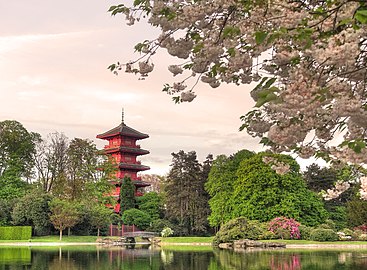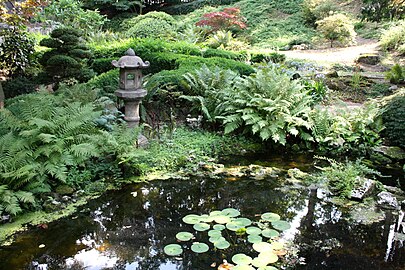Museums of the Far East
| |
| Website | Official website |
|---|---|
The Museums of the Far East (
The buildings were designed by the architect Alexandre Marcel at the beginning of the 20th century on behalf of King Leopold II. The three museums have been closed since 2013 because of structural weaknesses.[1][2] Some items from their collections are on public display at the Art & History Museum at the Parc du Cinquantenaire/Jubelpark of Brussels. The Chinese Pavilion and Japanese Tower were designated historic monuments in 2019.[3]
The museum complex is situated the
History
The idea for an outdoor display of oriental buildings, open to the public on the site, originated with
Work on a larger Chinese Pavilion (French: Pavillon chinois, Dutch: Chinees Paviljoen) began in 1905. The building was originally intended to be a restaurant, but never served the purpose for which it was intended. In 1909, with the death of Leopold II, the original plan for a museum was abandoned and the building was donated to the Belgian State where it served as part of the Trade Museum of the Ministry of Foreign Affairs.[4] From 1947 until 1989, the whole area was closed to visitors.[4] The museums' section on Japanese art is housed in a building near the Chinese Pavilion, originally intended to serve as a stable and garage for the complex.
The Chinese Pavilion and Japanese Tower were recognised as protected monuments in 2019.[3] After closing to the public in 2013 for structural reasons,[1][2] the complex was restored but not reopened to the public. The Flemish public broadcaster VRT reported in 2022 that the Federal Government had decided the previous year not to re-open the complex although no formal announcement had been made to this effect.[6]
Exhibits
The Museums of the Far East collectively refers to three separate museums situated close to each other, which can be accessed on the same ticket. They are: the Chinese Pavilion, the Japanese Tower and the Museum of Japanese Art.
One of the principal focuses of the museums' collection, Chinese porcelain and other chinoiserie, is housed in the Chinese Pavilion. The Pavilion's displays focus on Chinese art originally designed for export to the West.[7][8] It is situated in a Chinese garden.
The Japanese Tower, situated within a replica Japanese garden, displays Japanese art, mostly porcelain created for export to the West. The Museum of Japanese Art contains the bulk of the museums' collection of Japanese art and displays several suits of samurai armour, netsuke and decorative sword hilts, as well as woodblock prints and other artifacts. It is situated in the complex's carriage house and has only recently opened to the public.[9]
Temporary exhibitions are also regularly held at the museum.[10] Further examples of Asian art are also held by the RMAH at the Art & History Museum at the Parc du Cinquantenaire/Jubelpark in Brussels.
Gallery
-
View of one of the principal rooms of the Chinese Pavilion
-
Chinese Kiosk
-
View of the Japanese Tower from the Japanese garden
-
Japanese-inspired stained glass window depicting a Samurai, in the Japanese Tower
-
Part of the Japanese garden near the Japanese Tower
-
Out-building housing the collection of Japanese art, inaugurated in 2006
See also
- Japanese Garden of Hasselt
- List of museums in Brussels
- History of Brussels
- Culture of Belgium
- Belgium in the long nineteenth century
References
- ^ a b "Closure of the Museums of the Far East". KMKG. 25 October 2013. Archived from the original on 15 December 2018. Retrieved 2 June 2014.
- ^ a b "Museums of the Far East". Royal Museums of Art and History. February 2022. Archived from the original on 19 March 2022. Retrieved 14 March 2022.
- ^ Bruzz. Belga. 12 December 2019. Retrieved 13 December 2019.
- ^ a b c d "History". Royal Museums of Art and History. Archived from the original on 23 April 2013. Retrieved 2 April 2013.
- ^ Clericuzio, Peter. "The Shifting Meanings and Uses of the Japanese Tower at Laeken". Academia.edu. Archived from the original on 20 March 2023. Retrieved 2 April 2013.
- ^ "Worden Japanse Toren, Chinees Paviljoen en Hallepoort in Brussel binnenkort verkocht? Museum wil af van iconische gebouwen" (in Dutch). VRT NWS. 15 November 2022. Retrieved 20 November 2022.
- ^ "La porcelaine chinoise d'exportation". Kmkg-mrah.be. Retrieved 3 April 2013.
- ^ "Museums of the Far East". Brusselsmuseums.be. Archived from the original on 4 March 2016. Retrieved 3 April 2013.
- ^ "Collections". Kmkg-mrah.be. Retrieved 3 April 2013.
- ^ "Exposition Passée: Les douze heures des maisons vertes et autres beautés". Kmkg-mrah.be. Retrieved 3 April 2013.
External links
 Media related to Museums of the Far East at Wikimedia Commons
Media related to Museums of the Far East at Wikimedia Commons- Museums of the Far East at the Official Website of the Brussels Region






